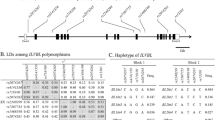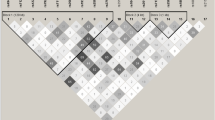Abstract
Aspirin-intolerant asthma (AIA) is an asthma phenotype characterized by the development of bronchoconstriction following ingestion of aspirin. Despite the well-defined pathological trigger, the underlying mechanisms of AIA are still unclear. With the biophysical characteristics of the human EMI domain-containing protein 2 (EMID2) gene in relation to the extracellular matrix deposition and epithelial-mesenchymal transition as pivotal characteristics of airway remodeling in asthma, we hypothesized that genetic polymorphisms of EMID2 might affect the development of AIA. In this study, the allelic associations of 49 single-nucleotide polymorphisms (SNPs) of the human EMID2 gene were evaluated from 163 AIA patients and 429 aspirin-tolerant asthma (ATA) subjects as controls in a Korean population. Logistic analysis showed that five SNPs (P = 0.01–0.04, but P corr > 0.05) and EMID2_BL2_ht2 haplotype (unique to the minor alleles of rs4727494 and rs13233066; P = 0.02; P corr = 0.02) were significantly associated with AIA. More interestingly, regression analysis of the decline of forced expiratory volume in one second (FEV1) by aspirin provocation revealed that 10 SNPs (P = 0.003–0.04) and four relevant haplotypes (P = 0.002–0.02) were significantly associated with the fall rate of FEV1 by aspirin provocation, indicating that genetic polymorphisms of EMID2 could cause meaningful deficits in the upper and lower airways among AIA patients. These findings provide evidence that EMID2 may be a susceptible genetic factor for aspirin hypersensitivity among asthmatics in Korean population.


Similar content being viewed by others
Abbreviations
- AIA:
-
Aspirin-intolerant asthma
- EMID2:
-
EMI domain-containing protein 2
- NSAID:
-
Non-steroidal inflammatory drugs
- ECM:
-
Extracellular matrix
- GINA:
-
Global Initiative for Asthma
- ACE:
-
Angiotensin converting enzyme
- SDS:
-
Sequence detection system
References
Backman KS, Greenberger PA, Patterson R (1997) Airways obstruction in patients with long-term asthma consistent with ‘irreversible asthma’. Chest 112:1234–40
Bel EH (2004) Clinical phenotypes of asthma. Curr Opin Pulm Med 10:44–50
Bressan GM, Daga-Gordini D, Colombatti A, Castellani I, Marigo V, Volpin D (1993) Emilin, a component of elastic fibers preferentially located at the elastin-microfibrils interface. J Cell Biol 121:201–12
Chakir J, Shannon J, Molet S, Fukakusa M, Elias J, Laviolette M, Boulet LP, Hamid Q (2003) Airway remodeling-associated mediators in moderate to severe asthma: effect of steroids on TGF-beta, IL-11, IL-17, and type I and type III collagen expression. J Allergy Clin Immunol 111:1293–8
Chetta A, Foresi A, Del Donno M, Bertorelli G, Pesci A, Olivieri D (1997) Airways remodeling is a distinctive feature of asthma and is related to severity of disease. Chest 111:852–7
Crapo RO, Casaburi R, Coates AL, Enright PL, Hankinson JL, Irvin CG, MacIntyre NR, McKay RT, Wanger JS, Anderson SD, Cockcroft DW, Fish JE, Sterk PJ (2000) Guidelines for methacholine and exercise challenge testing-1999. This official statement of the American Thoracic Society was adopted by the ATS Board of Directors, July 1999. Am J Respir Crit Care Med 161:309–29
Djukanovic R, Roche WR, Wilson JW, Beasley CR, Twentyman OP, Howarth RH, Holgate ST (1990) Mucosal inflammation in asthma. Am Rev Respir Dis 142:434–57
Doliana R, Mongiat M, Bucciotti F, Giacomello E, Deutzmann R, Volpin D, Bressan GM, Colombatti A (1999) EMILIN, a component of the elastic fiber and a new member of the C1q/tumor necrosis factor superfamily of proteins. J Biol Chem 274:16773–81
Hackett TL, Warner SM, Stefanowicz D, Shaheen F, Pechkovsky DV, Murray LA, Argentieri R, Kicic A, Stick SM, Bai TR, Knight DA (2009) Induction of epithelial-mesenchymal transition in primary airway epithelial cells from patients with asthma by transforming growth factor-beta1. Am J Respir Crit Care Med 180:122–33
Haitchi HM, Powell RM, Shaw TJ, Howarth PH, Wilson SJ, Wilson DI, Holgate ST, Davies DE (2005) ADAM33 expression in asthmatic airways and human embryonic lungs. Am J Respir Crit Care Med 171:958–65
Hedman J, Kaprio J, Poussa T, Nieminen MM (1999) Prevalence of asthma, aspirin intolerance, nasal polyposis and chronic obstructive pulmonary disease in a population-based study. Int J Epidemiol 28:717–22
Hedrick PW (1987) Gametic disequilibrium measures: proceed with caution. Genetics 117:331–41
Holgate ST, Polosa R (2006) The mechanisms, diagnosis, and management of severe asthma in adults. Lancet 368:780–93
Jeimy SB, Tasneem S, Cramer EM, Hayward CP (2008) Multimerin 1. Platelets 19:83–95
Jenkins HA, Cool C, Szefler SJ, Covar R, Brugman S, Gelfand EW, Spahn JD (2003) Histopathology of severe childhood asthma: a case series. Chest 124:32–41
Knight DA, Lane CL, Stick SM (2004) Does aberrant activation of the epithelial-mesenchymal trophic unit play a key role in asthma or is it an unimportant sideshow? Curr Opin Pharmacol 4:251–6
Leimeister C, Steidl C, Schumacher N, Erhard S, Gessler M (2002) Developmental expression and biochemical characterization of Emu family members. Dev Biol 249:204–18
Loren ML, Leung PK, Cooley RL, Chai H, Bell TD, Buck VM (1978) Irreversibility of obstructive changes in severe asthma in childhood. Chest 74:126–9
Mauad T, Xavier AC, Saldiva PH, Dolhnikoff M (1999) Elastosis and fragmentation of fibers of the elastic system in fatal asthma. Am J Respir Crit Care Med 160:968–75
Mauad T, Silva LF, Santos MA, Grinberg L, Bernardi FD, Martins MA, Saldiva PH, Dolhnikoff M (2004) Abnormal alveolar attachments with decreased elastic fiber content in distal lung in fatal asthma. Am J Respir Crit Care Med 170:857–62
McDonald JR, Mathison DA, Stevenson DD (1972) Aspirin intolerance in asthma. Detection by oral challenge. J Allergy Clin Immunol 50:198–207
Minshall EM, Leung DY, Martin RJ, Song YL, Cameron L, Ernst P, Hamid Q (1997) Eosinophil-associated TGF-beta1 mRNA expression and airways fibrosis in bronchial asthma. Am J Respir Cell Mol Biol 17:326–33
Nomura A, Uchida Y, Sakamoto T, Ishii Y, Masuyama K, Morishima Y, Hirano K, Sekizawa K (2002) Increases in collagen type I synthesis in asthma: the role of eosinophils and transforming growth factor-beta. Clin Exp Allergy 32:860–5
Nyholt DR (2004) A simple correction for multiple testing for single-nucleotide polymorphisms in linkage disequilibrium with each other. Am J Hum Genet 74:765–9
Pagani F, Baralle FE (2004) Genomic variants in exons and introns: identifying the splicing spoilers. Nat Rev Genet 5:389–96
Sakagami T, Jinnai N, Nakajima T, Sekigawa T, Hasegawa T, Suzuki E, Inoue I, Gejyo F (2007) ADAM33 polymorphisms are associated with aspirin-intolerant asthma in the Japanese population. J Hum Genet 52:66–72
Song T, Li G, Jing G, Jiao X, Shi J, Zhang B, Wang L, Ye X, Cao F (2008) SUMO1 polymorphisms are associated with non-syndromic cleft lip with or without cleft palate. Biochem Biophys Res Commun 377:1265–8
Stephens M, Smith NJ, Donnelly P (2001) A new statistical method for haplotype reconstruction from population data. Am J Hum Genet 68:978–89
Szczeklik A, Nizankowska E, Duplaga M (2000) Natural history of aspirin-induced asthma. AIANE investigators. European network on aspirin-induced asthma. Eur Respir J 16:432–6
Tagaya E, Tamaoki J (2007) Mechanisms of airway remodeling in asthma. Allergol Int 56:331–40
Van Eerdewegh P, Little RD, Dupuis J, Del Mastro RG, Falls K, Simon J, Torrey D, Pandit S, McKenny J, Braunschweiger K, Walsh A, Liu Z, Hayward B, Folz C, Manning SP, Bawa A, Saracino L, Thackston M, Benchekroun Y, Capparell N, Wang M, Adair R, Feng Y, Dubois J, FitzGerald MG, Huang H, Gibson R, Allen KM, Pedan A, Danzig MR, Umland SP, Egan RW, Cuss FM, Rorke S, Clough JB, Holloway JW, Holgate ST, Keith TP (2002) Association of the ADAM33 gene with asthma and bronchial hyperresponsiveness. Nature 418:426–30
Ward C, Pais M, Bish R, Reid D, Feltis B, Johns D, Walters EH (2002) Airway inflammation, basement membrane thickening and bronchial hyperresponsiveness in asthma. Thorax 57:309–16
Warner JO, Marguet C, Rao R, Roche WR, Pohunek P (1998) Inflammatory mechanisms in childhood asthma. Clin Exp Allergy 28(Suppl 5):71–5, discussion 90-1
Yang Y, Haitchi HM, Cakebread J, Sammut D, Harvey A, Powell RM, Holloway JW, Howarth P, Holgate ST, Davies DE (2008) Epigenetic mechanisms silence a disintegrin and metalloprotease 33 expression in bronchial epithelial cells. J Allergy Clin Immunol 121:1393–9, 1399 e1-14
Acknowledgements
This work was supported by a grant from the Korea Health 21 R&D Project (A010249); a grant number M1-0302-00-0073 from Korea Science and Engineering Foundation (KOSEF) funded by the Korea government (MEST) (No. 2009-0080157); an Intramural Research Grant of the Korea National Institute of Health (grant number 4800-4845-300-260-00); an Intramural Research Grant from Sogang University (grant number 200810021.01); and a Priority Research Centers Program through the National Research Foundation of Korea (NRF) funded by the Ministry of Education, Science and Technology (2009-0093822). The DNA samples were generously provided by Soonchunhyang University, Bucheon Hospital Biobank, a member of the National Biobank of Korea, supported by the Ministry of Health, Welfare and Family Affairs, Republic of Korea.
Conflicts of interest
The authors declare no conflict of interests.
Author information
Authors and Affiliations
Corresponding authors
Electronic supplementary materials
Below is the link to the electronic supplementary material.
Supplementary Table 1
Variants of EMID2 included in this study (DOC 67 kb)
Supplementary Table 2
Logistic analysis of the SNPs in EMID2 between AIA and ATA patients (DOC 122 kb)
Supplementary Table 3
Logistic analysis of the haplotypes in EMID2 between AIA and ATA patients (DOC 50 kb)
Supplementary Table 4
Association analysis between SNPs of EMID2 gene and the fall of FEV1 by aspirin provocation (DOC 79 kb)
Supplementary Table 5
Association analysis between haplotypes of EMID2 gene and the fall of FEV1 by aspirin provocation (DOC 47 kb)
Rights and permissions
About this article
Cite this article
Pasaje, C.F.A., Kim, JH., Park, BL. et al. A possible association of EMID2 polymorphisms with aspirin hypersensitivity in asthma. Immunogenetics 63, 13–21 (2011). https://doi.org/10.1007/s00251-010-0490-8
Received:
Accepted:
Published:
Issue Date:
DOI: https://doi.org/10.1007/s00251-010-0490-8




